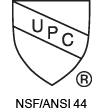Frequently Asked Questions
1. What type of softener do I have?
Your water softener is a fully automatic Demand Initiated, metered system. This means the softener meters, or keeps track of, the water used in the home. It uses this information to determine when to perform the regeneration, or cleaning cycle. The control of the softening process automatically adjusts to your water use. For example, if you have company and your water use increases substantially, the softener will adjust to insure you don’t run out of soft water. If you go away for a time and are not using any water in the home, the softener will adjust again and not perform a regeneration cycle thereby saving salt and water.
2. What does it cost to operate my system?
Your softener uses about as much electricity to operate as an alarm clock. Other costs include water and salt but vary depending on how much water you use. A typical household will use about 1 to 1.5 bags of salt per month (about $3-4.50/bag).
3. What type of salt do I use?
Basically, salt is salt. However, some makes of salt contain more dirt in the bag than others. We recommend Morton™ or Diamond Crystal™ salt pellets. Salt is readily available at most grocery stores and home improvement centers.
4. How much water does the system use while regenerating?
Depending on the system you purchased, somewhere between 40 and 60 gallons.
5. Can I use potassium?
Potassium can also be used in the water softener. When Potassium is used however, the softener control valve will need to be adjusted. Add 3 grains to the feed water hardness setting i.e. feed water = 18 grains + 3 for potassium = 21 grains entered for the feed water setting. Also keep the level of potassium in the brine tank low.
6. How much salt or potassium do I put in the brine tank?
We recommend keeping the level of salt in the brine tank about half full for most households. Larger households can start out with more. Let the salt level drop down to the water level before adding more salt. Potassium should be kept as close to the water level as is practical to help prevent a “salt bridge”. Periodically you may experience a salt bridge. A salt bridge occurs when the salt forms a crust right at the water level in the brine tank. The salt remains suspended above the water and cannot make the brine solution required for the regeneration of the softener bed. If you do experience a salt bridge, simply tap a broom handle down in the salt to break up the bridge. Wait at least 1 hour, and then manually regenerate the softener.
7. How much space will my system take?
Please refer to page 5 in our manual.
8. Should I clean the Brine Tank?
Normally it is not necessary to clean the brine tank. In time dirt and silt can build up in the brine tank and if you choose you can clean it out. Let the salt level drop down very low. The night before you clean, manually regenerate the softener. Disconnect the brine line and dump out the old salt, (Do not dump the old salt anywhere near living plants). Reconnect the brine line, add about (3) gallons of water, and add the new salt.
9. How do I change the control valve settings?
It is not necessary to change the control valve settings other than the ones described in the owner’s manual. Over the course of several months it is possible the display will not show the correct time of day due to power fluctuations. Reset the control to the correct time of day. If your feed water hardness changes, reset the control to the new hardness. Other settings are programmed at the factory for optimum efficiency and do not need to be changed.
10. How much sodium or potassium is added to the softened water?
The softening process does add some sodium or potassium to the conditioned water. The following chart
shows approximately how much sodium or potassium is added to one quart
of conditioned water based on the amount of feed water hardness.

For comparison, (2) slices of white bread contain approximately 278
milligrams of sodium and (2) cups of milk contain approximately 226
milligrams of sodium. One large banana contains approximately 600
milligrams of potassium.
11. How do I bypass the softener?
You may need to bypass the softener for service or if you do not want your household water to pass through the softener. See the owner’s manual for instructions on bypassing the softener. The instructions are also shown on the bypass valve. Make sure you depressurize the system before performing any service or removing the softener. See the “WARNING” in the owner’s manual.
12. What should I do with the softener while on vacation or during extended periods of non-use?
It is not necessary to shut down the softener for periods of non-use equal to two-week to one-month vacations. If however, you are a temporary resident and leave for periods of four to six months, we recommend you shut the softener down. Put the softener in bypass and unplug it. When you return you will need to start the softener up. Make sure there are approximately (3) gallons of water in the brine tank, plug the softener in, and manually regenerate the softener.


